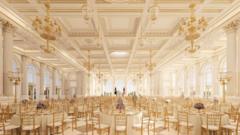The Palm House and Waterlily House, two cherished Victorian-era glasshouses located at London’s Kew Gardens, are set to undergo significant renovations starting in 2027. These historic structures have been a staple for plant enthusiasts, but signs of wear and tear have become increasingly visible over the years.
Reuben Briggs, who oversees capital projects at the Royal Botanic Gardens, Kew, expressed concerns about the aging infrastructure. The Palm House, built in 1848, is suffering from corrosion and dampness that threaten its integrity. “The building is experiencing serious signs of deterioration,” Briggs explained, citing issues such as blistering paint and the effects of high humidity within the tropical climate that the greenhouse is designed to emulate.
Kew Gardens announced that the Palm House will close for a four-year period of renovations in tandem with the adjacent Waterlily House, aiming to not only restore but also future-proof these facilities against changing climate conditions. The renovations will focus on preserving the architectural heritage while also enhancing the environment for both plants and visitors alike.
Briggs emphasized that the upcoming renovations would take a comprehensive approach, aiming to bolster the structures’ resilience in a changing climate. “Preserving these historic buildings is vital, but we also want to ensure they can better support our plant collections and the experience for our visitors,” he said.
The renovations represent a commitment to sustainability and climate awareness, reflecting a growing trend among historic institutions to adapt to modern environmental challenges while safeguarding cherished legacies. With construction slated to begin in 2027, visitors can look forward to a revitalized experience at Kew Gardens in the years to come.
Reuben Briggs, who oversees capital projects at the Royal Botanic Gardens, Kew, expressed concerns about the aging infrastructure. The Palm House, built in 1848, is suffering from corrosion and dampness that threaten its integrity. “The building is experiencing serious signs of deterioration,” Briggs explained, citing issues such as blistering paint and the effects of high humidity within the tropical climate that the greenhouse is designed to emulate.
Kew Gardens announced that the Palm House will close for a four-year period of renovations in tandem with the adjacent Waterlily House, aiming to not only restore but also future-proof these facilities against changing climate conditions. The renovations will focus on preserving the architectural heritage while also enhancing the environment for both plants and visitors alike.
Briggs emphasized that the upcoming renovations would take a comprehensive approach, aiming to bolster the structures’ resilience in a changing climate. “Preserving these historic buildings is vital, but we also want to ensure they can better support our plant collections and the experience for our visitors,” he said.
The renovations represent a commitment to sustainability and climate awareness, reflecting a growing trend among historic institutions to adapt to modern environmental challenges while safeguarding cherished legacies. With construction slated to begin in 2027, visitors can look forward to a revitalized experience at Kew Gardens in the years to come.



















